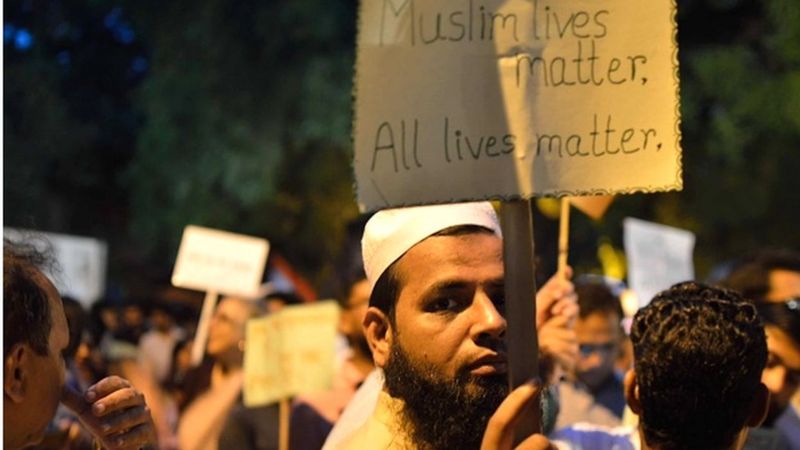
Islamophobia is ever increasing, owing to many factors and has translated into large scale violence against Muslim minority community in India
ON Thursday, 23 September 2021, the Assam police killed two members of a poor Muslim community in Dholpur area of Darrang district during an eviction drive that has displaced nearly 800 families. The victims were identified as 12-year-old Sheikh Farid and 33-year-old Moinul Haque, a daily wage labourer, whose family has lived in Assam since several decades. A viral video of the incident shows a photographer (identified as Bijoy Bania, associated with the local administration) stomping and mercilessly pouncing on the body of Haque as he lay dying due to a bullet wound.
While anti-encroachment drives are a regular affair in different parts of India, and such measures oftentimes result in some form of a clash between the government officials, police and the affected people, the Dholpur incident has garnered attention because it occurred in a particular political context, and was, of course, accompanied by abominable cruelty by the photographer Bania and disproportionate force by the police.
Violence against members of the Muslim community in Assam was preceded by a series of attacks on poor Muslims (usually vendors and small traders) in different parts of India by vigilante groups (reportedly) belonging to Hindutva organisations and outfits.
For example, on 22 August, Tasleem Ali, a bangle-seller, was thrashed in Indore’s New Govind Area (Madhya Pradesh) for selling his wares in a Hindu-locality. On the complaint of the daughter of an accused attacker, Ali was booked under POSCO and IPC sections 354 (assault or criminal force on a woman), 354-A (sexual harassment), 467, 468, 471 (forgery), 420 (cheating) and 506 (criminal intimidation). In Vikas Bazar area of Mathura (Uttar Pradesh), a right-wing mob led by some Devraj Pandit harassed a Muslim dosa vendor and vandalised his stall while shouting “Krishna bhakt ab yudh karo, Mathura ko bhi shudh karo (Devotees of Krishna wage war, help purify Mathura).” The mob objected to the stall’s name ‘Shrinath Dosa Corner’, and accused the Muslim owner of waging “economic jihad.”
Such incidents abound. For a complete list, you can follow Alishan Jafri (@asfreeasjafri) Twitter account, which documents anti-Muslim violence and hate crimes in India.
Some political observers see increasing anti-Muslim incidents as linked to the upcoming Lok Sabha and State elections, because religious polarisation play in favour of certain political parties.
Whatever be the case, the genie has been let out of the bottle. A vast majority of young Indians, from the majority community, have been ideologically radicalised. And this does not portend well for the future. As Debasish Roy Chowdhury (Haaretz, 26 Sep) says, “In reality, the radicalization of the majority is a much bigger threat confronting India than minority extremism.” Islamophobic narratives and anti-Muslim attacks have been almost normalised, and Indian Muslims and many conscientious Indian Hindus are afraid (and warning) that this anti-minority bigotry may eventually lead to a more violent future, something akin to Europe in the 1930s.
While the situation seems utterly pessimistic, there are possible ways which could be tried to arrest the rising wave of anti-Muslim movement. Firstly, it is important to meticulously document the incidents of anti-minority hate crime, so as to provide evidence during the judicial process, whenever that happens, and get people involved in the crime prosecuted. Secondly, raising awareness about Islamophobia through varied mediums, channels and platforms. Making people understand Islamophobia and its different facets could potentially act to prevent the youth from the majority community from becoming radicalised under the influence of extremist ideologies that have a free run and robust infrastructure for their amplification. Finally, to campaign for a legislation (on the model of The Prevention of Atrocities Act, 1989) that recognises Islamophobia as a religious form of discrimination. Such a legislation will potentially act as a deterrent against anti-Muslim abuse and violence, and instil some confidence among the members of the largest minority community in India.
The views expressed in the article are the author’s own and do not necessarily represent the editorial stance of Kashmir Observer
- The author is an independent researcher
Follow this link to join our WhatsApp group: Join Now
Be Part of Quality Journalism |
Quality journalism takes a lot of time, money and hard work to produce and despite all the hardships we still do it. Our reporters and editors are working overtime in Kashmir and beyond to cover what you care about, break big stories, and expose injustices that can change lives. Today more people are reading Kashmir Observer than ever, but only a handful are paying while advertising revenues are falling fast. |
| ACT NOW |
| MONTHLY | Rs 100 | |
| YEARLY | Rs 1000 | |
| LIFETIME | Rs 10000 | |













